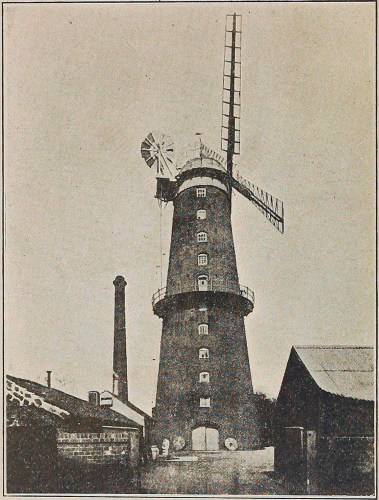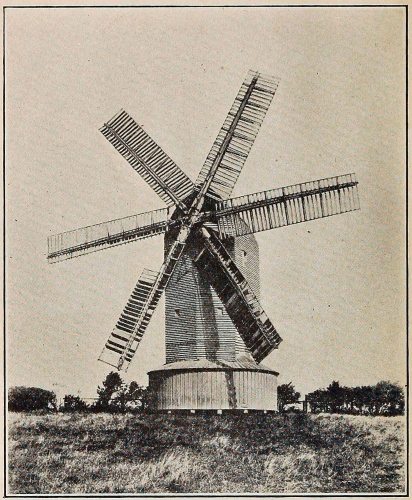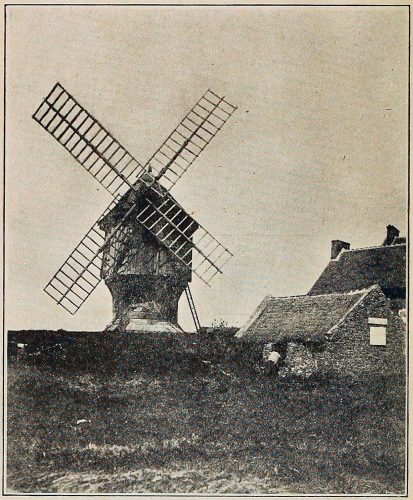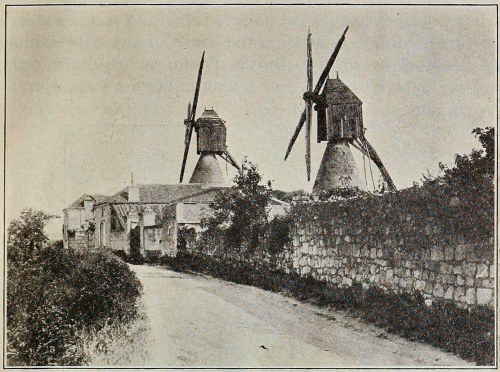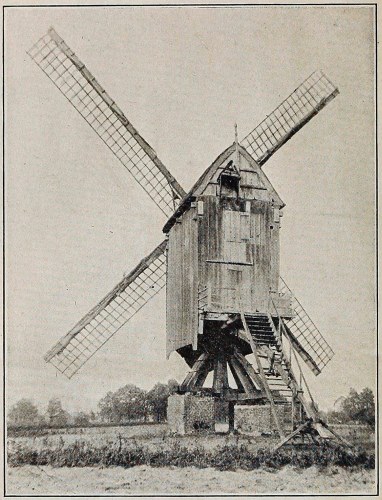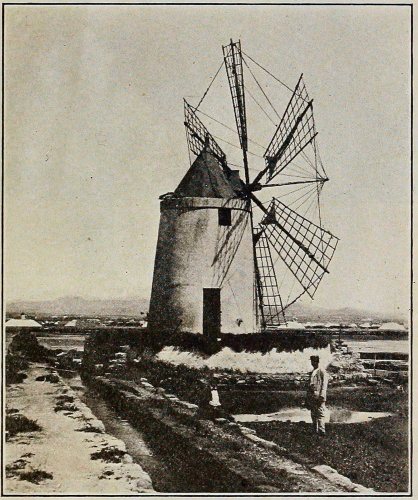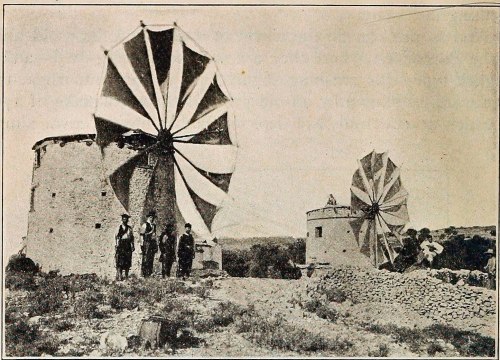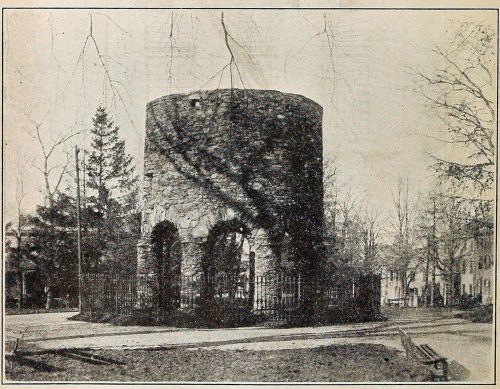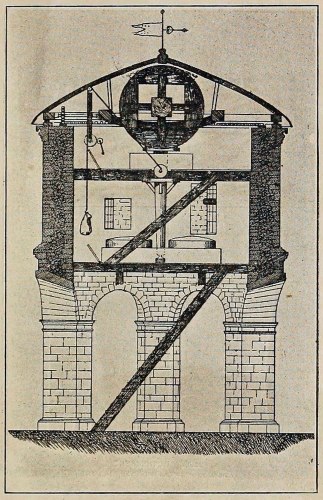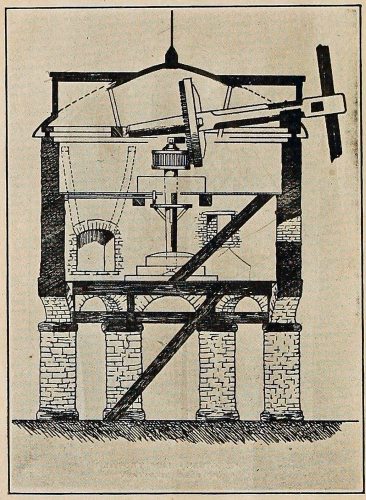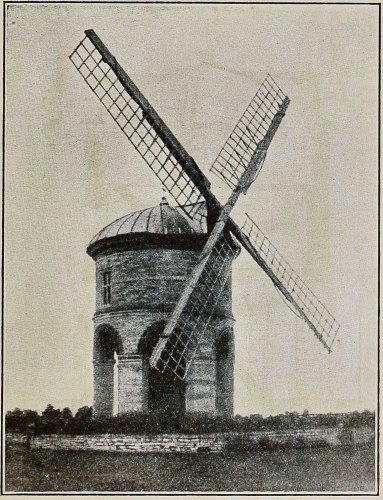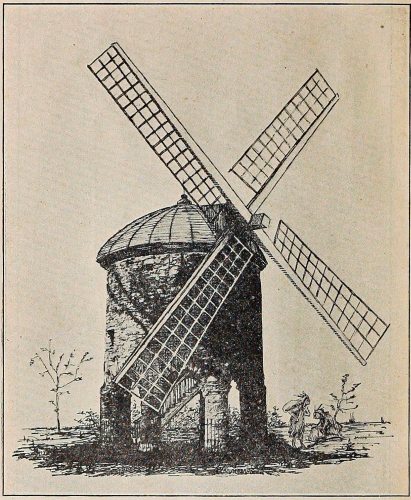
|
(In certain versions of this etext [in certain browsers] clicking on the image, will bring up a larger version.) (etext transcriber's note) |
WINDMILLS, PICTURESQUE AND
HISTORIC: THE MOTORS OF
THE PAST
BY
F. H. SHELTON
Philadelphia. Member of the Institute
Reprinted from the Journal of The Franklin Institute
February, 1919
![[Image of colophon unavailable.]](images/colophon.png)
PRESS OF J. B. LIPPINCOTT COMPANY 1919
(Reprinted from the Journal of The Franklin Institute,
February, 1919.) {171}
WINDMILLS, PICTURESQUE AND HISTORIC: THE
MOTORS OF THE PAST.[A]
BY
F. H. SHELTON.
Philadelphia.
Member of the Institute.
The pessimist says that man is a lazy animal and that he invents machines to save himself work. The optimist, that man is an industrious creature who invents machines that he may accomplish the more. Whichever doctrine is right, there is but little question that of all the ingenious contrivances evolved by man none is more picturesque, of more historic interest nor of greater usefulness in its day than the old-fashioned windmill, the world’s principal motor for some eight hundred years. And “motor” is the viewpoint to take of this old piece of mechanism, for just as the later devices of steam, electricity or gasoline are for the purposes of making power for the needs of man, so was this old appliance for the prime purpose of securing power from the wind, and by thus harnessing that most widely distributed of Nature’s forces, of enabling the accomplishment of work far beyond the limits of manual power.
The steam engine came into use in the early part of the nineteenth century. By 1825 most of the principal English cities had it in use. Before that period, and dating back to remote ages, the only sources of power—other than man or bullocks, etc.—were the two great forces of wind and water. But only countries of waterways and varying levels afforded waterfalls; while the wind was universal. Therefore, while water wheels were in use in parallel periods with the oldest of windmills, in number they were infinitely less, so that one can properly say that the world’s motor for some eight centuries was the old-time windmill. These eight centuries are from about 1000 to 1825, when, with the advent of Watt’s invention, the zenith of windmill design and use had been attained. After that date they so declined that in fifty years not only had new construction ceased, but the old structures in very large measure had fallen into decay and{172} abandonment. It is evident from the above that an account of this old, picturesque, historic and effective tool of mankind should have some interest, both from the standpoint of engineering and that of sentiment; and it is believed that what follows will give the essential facts relating to it. It may be proper to say here that what is related applies entirely to the old-style windmill, and in no measure whatever to the modern American type of windmill, which, while cheap, effective and useful, is nevertheless a prosaic, galvanized iron, squeaky thing, of which happily the larger proportion of the millions annually made is exported out of our country!
While the antiquity of windmills is traced by some back to the Romans there is really nothing very definitely known of their existence before the period of the Crusaders. They were said to have been brought into central Europe in that period from the Far East; though this is open to question. Practically their origin is lost in antiquity, and we only know that they appear in the earliest records as existent in some form or other.
But by 1200 they were well established. The first English windmill is of 1191. There are numerous records of them in the thirteenth century. There is a brass tablet of 1349 at Lynn church, with a windmill graven on it. In old stained glass of the early churches windmills are shown in some of the landscapes; as at Great Greenford and Fairfield. In a view, “London in the time of the Tudors” (1560), windmills are seen; and Great Windmill Street commemorates to this day the location of one in the past in that city. Elsewhere it was the same. Rembrandt, of the early part of the seventeenth century, shows such mills in some of his pictures; and in the early prints and views of France, Germany and other countries is abundant evidence of the use of these old, useful machines, in various forms, places and ways.
What was standard in the old world was naturally brought into the new, and so we find in America, concurrent with the colonies and settlements of the early days, the introduction and use of windmills. The Dutch in New Amsterdam, in 1625 and later; the Swedes on the Delaware, in 1643; the English in Rhode Island, in 1665 and 1675, and Boston, in 1660; and on the Carolina coast—all had their mills, as shown by early records, maps and views. And these mills were logically the types used by the{173} respective settlers, according to the district from which they had come. For instance, the old mill in Somerville, Mass., built in 1710 by Jean Mallet, a French Huguenot, is of the pure French type; as were those near Detroit, by the followers of the fortunes of Cadillac; while those in Talbot, Kent and Dorset counties, Maryland, reflected the clear English design of the old country. The same applies to the numerous ones erected in the colonial days of 1725 to 1775, in Easthampton, Bridgehampton, etc., on Long Island; at various points on Cape Cod; at Nantucket (1746); in numerous instances on Newport Island, Rhode Island, etc. A notable one of this type and period was that on Windmill Island in the Delaware River, shown in an old view, “An east prospect of the City of Philadelphia,” 1746. All these reflected the English design of the emigrant settlers, bringing with them and promptly setting up and using the motors or machinery of the mother country.
There are two forms into which these old mills can be grouped, viz., vertical and horizontal. By that is meant the relative position of the wheel and shaft. The vertical is that form in which the wheel is vertical, mounted on a shaft which is horizontal or nearly so. This is the form almost universal, for while various instances of the other have been tried, scarcely one in a thousand has been used compared with the vertical type. The reason for this is that in the vertical form of wheel, its face directly confronting the wind, all vanes are acted upon at once, and there is not only the greatest resulting power, but the greatest simplicity of construction and of operation and handling. The horizontal wheel, on the other hand, occupying a horizontal zone and attached to a shaft that is vertical, like the usual small water turbine, in position (but not in the fluid impact) receives the wind impact upon only some of the vanes at a time—not the whole circumference—with less proportional power and greater complexity of construction. So secondary has been the use of this style of windmill that consideration of it is negligible.
From the design standpoint, windmills involve four essential component parts:
(a) A tower, or means of support for the moving wheel and mechanism.
(b) A revolving wheel that receives the impact of the wind, converting it into power.{174}
(c) Some means of turning the wheel, to follow the shifting of the wind; and,
(d) The driven machinery.
(A) The Towers or Supports.—The support in the earliest form of mill was merely a post, made of a suitable log or tree trunk—sometimes 30 inches thick—upon which the entire structure was carried or hung and pivoted, so that it could turn freely to the wind. This was the original type—the old “post-mill,” appearing in the earliest known prints and records, and alone used until about 1650. At that time the “tower mill” was developed, and this, of larger possibilities, soon resulted in great structures of that style being built, that generally replaced and threw far into the shade the earlier and simple post form.
The towers of this latter form of old windmill were made of every conceivable or possible form and material. Straight or cylindrical; tapering or cone shaped; octagonal or multi-sided; even bottle shaped, like a mammoth milk bottle of the present time. Again, on open arches, as in two notable structures later referred to—anything to carry the overhead work, according to the fancy or purse or conditions governing the builder. Of brick or stone or wood; slate, shingle or thatch covered, in height these towers ranged from 25 to 100 feet. The largest ever built was at Great Yarmouth, England, 11 stories high, and over 100 feet, exclusive of the great vanes. The great Dutch grist mills were however, a close second in height, and with a base of some 35 feet and a top width of 16 feet were massive structures indeed. These tall structures were divided by various floor levels, the lower rooms thus formed containing the mill-stones or saw or other driven machinery, while the upper ones were used for living quarters or storage. The structure of the smaller post mills, however, being suspended on the centre posts, was never of stone or brick, but wholly of wood, and these rotating or movable buildings ranged in size from about 10 by 12 feet to 16 by 24 feet in the larger ones, and up to two stories in height.
At the top of the mills, of course, was located the wheel shaft and gearing, and to protect this from the weather there was always a covering or “mill head” or top, and these tops have taken a great variety of interesting forms, for no apparent particular reason, and yet often a fixed style, following some geographical location. For instance, in France the almost universal{175}
All pivoting on single centre post support.

Small form. Large form. North Carolina, U.S.A. England, turret form.
TURNTABLE MILL. HYBRID MILLS.
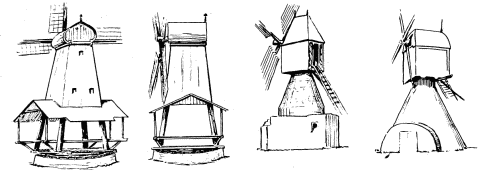
Holland, side and end view. France, grist mill. Holland, dumping mill.

| England and Holland, brick. |
Holland, Germany, Sweden, etc., wood. |
France, stone. |
Hungary, stone. |
Spain, stone. |
Turkey and Eastern Mediterranean. |
| THE FOUR TYPES OF WINDMILLS. | |||||
or characteristic shape is that of a steep true cone; in Denmark, Sweden, etc., a Turk’s head or turban type was the standard; also in England, on the great tower mills. Yet in Holland, on the same type of mill, such was never used, but a distinct Dutch form of irregular shape, and almost always thatched. And in the Mediterranean countries the tops become so flattened or{176} lowered as to in some cases almost disappear. The accompanying plate well illustrates these structural and geographical differences.
While the old mills all divide into either post or tower mills, there are yet two well-defined further forms, or variations of type, that should be remarked.

| England, Turk head brick tower mill. |
South of England, wood tower mill. |
Holland, tower mill. |
Holland, turntable type. |

| France, tower mill. | France, hybrid mill. | Belgium, tower mill. | Hungary, tower mill. |

| Mediterranean, tower mill. | Plain, post mill. | Belgium, post mill. | Barbadoes, tower mill. |

| Rhode Island, wood tower mill. |
Long Island, wood tower mill. |
Sweden, wood tower mill. |
Turkey, stone tower mill. |
| TYPICAL WINDMILL HEADS. | |||
Sometimes a tower mill would be constructed on a circular timber framework or base, carried on rollers or iron balls, forming a large turntable, enabling the turning of the entire edifice to the wind, as need be, the same as a locomotive turntable or a rotary drawbridge is turned. This therefore parallels the post {177}
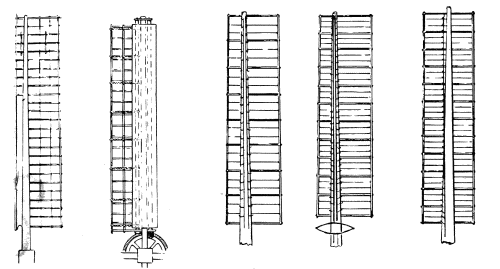
| Usual canvas covered sweep. | England, Bywater’s rolling canvas. | England, Cubit’s patent shutter. | England, Meikle’s spring sweep. | England, double shutter. |
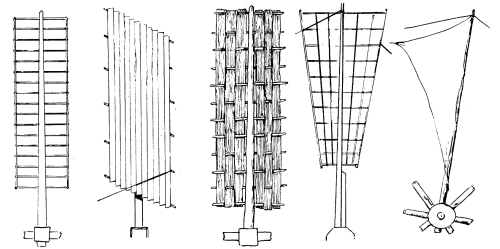
| France, double sweep. |
France, folding sweep. |
Primitive sweep, interlaced boards. |
Mediterranean, double sweep canvas. |
Mediterranean, flying jib; Greece, Turkey, etc. |
| TYPICAL WINDMILL ARMS. | ||||
mill type, in which the entire structure is turned to follow the wind, but turning on this turntable base instead of a post. This form was extensively used in the saw mill and lumber districts of Holland.{178}
The other variation is what may be called a hybrid form—part post type, part tower type. In this the contained machinery is fixed in the base, and does not rotate, being thus of the tower mill design; while in the upper part of the mill a rectangular wood housing, like a post mill, is pivoted and revolves with a tail beam, as in the post design. Such hybrid forms are found in Holland and in the valley of the Loire, at Saumur, Chinon, etc.
(B) The Sweeps.—With mills built for centuries and by all countries, it is but natural to expect to find a wide range of form in this most characteristic part of a windmill—the sweeps or vanes; and in this one is not disappointed.
The usual, earliest and simple form was that of a canvas or sail covered framework. This canvas covering could be reefed to suit the strength of the wind, and the four measures of sail spread were known as “full sail,” “quarter sail,” “sword point” and “dagger point,” respectively—these last two, from a fancied resemblance of the shape of the partly furled or reefed cloth to the point of a sword or dagger. But these canvas sails were laborious to handle, and in no sense automatic in varying the amount of surface according to the strength of the wind, which resulted in numerous schemes for betterment. The most successful of these and that known as “patent” sails was the invention of Cubit, an Englishman, who, a century and a quarter or so ago, devised a series of wood shutters forming the face of the vane, all connected by little levers and cords or rods to a counterweight. This, when adjusted, would cause the shutters to give a full, flat surface to the wind, but if the wind should increase to a danger point, its force would overcome the pull of the weight and the hinged shutters would all open the necessary amount to spill some of the wind through and thus ease the pressure on the sweeps. This was a good deal like a huge Venetian blind arrangement, as to the shutters or slats; and in some cases these shutters worked against the tension of a spring instead of the pull of a weight, and such were known as Meikle’s “spring sweeps.” Still another arrangement—Bywater’s—was that of the canvas being mounted upon a long roller, a good deal like a modern window shade, which rolled and unrolled as needed; but this was rather complicated and not much in vogue.
It was usual to have four-fifths of the area of the sweeps on one side of the arm and one-fifth on the other, and these were{179} “single sweeps”; while those in which there was a wide area on both sides—as almost the universal practice in France—were known as “double sweeps.” Wood has been used as a sweep covering as well as canvas—as for instance in France, where one finds some of the most primitive, crude mills, with sails made of thin boards interlaced or woven into the vane framework; while, on the other hand, one also finds quite an elaborate construction. This is in the mills of the Loire valley, in which a dozen parallel boards on each vane are rigged much like a great Japanese fan, which when open presents a large surface, but when closed presents but little, the boards or wood strips overlapping and resting one upon the other. This construction I have found nowhere but in that section.
Going still further toward the primitive, we find in the Mediterranean, especially in the eastern end, in Asia Minor, in the vicinity of Smyrna, Turkey; the islands of Rhodes, Chios, Samos, and of Greece and the Sea of Marmora, a construction consisting simply of poles, anywhere from six to a dozen, stuck in the hub, carrying flying jibs, resulting in a wheel not far different in form from the paper spinwheel that a child may make! In Sicily and the Balearic islands these become a little better, having the wood framework to hold the canvas in the most effective position, and they form a transition phase between the crude jib wheels of the Orient and the elaborated types of the north.
In number the arms of the usual mill were four—and almost universally, for this was not only the simplest and strongest construction compared with the difficulty of framing six or eight firmly at the hub, but also the most effective. For it was found that the wind had to have a certain amount of exit space between the vanes to get away freely, and that if this part of the circle was too much filled with additional sweeps no corresponding gain in power was secured. A few very fine examples, however, can be found of these five-and six-arm mills, as in the famous 100-foot brick tower mill of Whitby, England, with five arms and its Turk’s head top; and at Lewes, where a fine turret mill and others have five and six arms.
The length of these arms in an ordinary size mill was about 30 feet, giving a diameter to the wheel of 60 feet; but in the big tower mills referred to the arms were sometimes 50 and 60 feet long, making the wheels well over 100 feet in diameter. The{180} usual speed was about 16 revolutions a minute. If faster than 20 a danger point was reached that was very real, for there have been many cases of runaway mills, resulting from defective brakes or accident or carelessness; in which accidents millers have been caught in the vanes or sweeps and carried around and around and thrown off; or millstones bursting from too high speed have amputated the miller’s legs; or friction heat has set the structure afire.
It is of course obvious that the surface of these windmill sails could not be really flat, as in that case the wind blowing against it would merely recoil and exert no power effect. A warp or twist was requisite, that the wind might give a thrust to the sail in passing through the wheel, precisely the reverse action of a screw propeller on a boat.
This twist was known as the “angle of weather” or “bosom,” and the precise amount and form were the subjects of many early abstruse and learned studies. Practice finally settled down to an angle of about 17° at the inner end and about 8° at the outer end of the sail as being the most effective.
The mounting of these huge wheels was a matter of some moment, requiring very heavy construction, and this resulted in the use, as a rule, in all the earlier and medium size mills of a great shaft or log, turned or hewed octagonal, carried by gudgeon bearings, on old blocks of soapstone, or greased oak, or cast iron bearings at either end. Into the outer projecting end, outside the roof, the square ends of the vane shafts or sweeps were mortised and bound with straps and bolts of iron. Later and in the larger mills, and after foundry work was more available, these “great-shafts” were made of iron, giving much better bearings and enabling the sweeps to be bolted into square openings more conveniently. But with all these mills, especially the early simpler forms, there was an enormous loss in dead weight moved and in friction, and it is doubtful whether in most of them 50 per cent of the force of the wind reached the mill stones below for useful work.
There was a popular belief that the wind came down from the heavens above, and that therefore the wheel should “look up” a little, to best meet it; with the result that the shaft of the mill was virtually never set level, as one might suppose, but always with the outer end a little higher than the inner, which angle of{181} uplift varied from 5° to 10°. A very practical result of this was also gotten, in the necessary clearance of the tapering tower by the revolving vanes. For these revolving vanes were something to be respected—a 60-foot wheel, for instance, weighing several tons and having a periphery speed of perhaps 3000 feet a minute, and more than one horse or cow straying into the path of the arms in a mill in operation has been struck and paid the penalty. To guard against that, mills were at times set upon a dais or raised foundation, or fenced in.
The great shaft would have mounted upon it a “great wheel,” from 8 to 12 or 15 feet in diameter, with cog teeth, and these engaged in a pinion or lantern or trundle or wallower wheel, as variously styled, on a vertical shaft, which led to the machinery below, and there, by any suitable and usual gear work of the olden times, whatever grist, saw, grinding, stamping or other machinery was to be driven would be duly operated by the wind power from above.
(C) The Tail Beam or Vane.—The third essential feature of these old mills was the device for keeping the wheel head-on to the wind, for the purpose of securing the fullest amount of power. And this was quite a point, in view of the perpetual shifting of the wind.
The first arrangement was that of a long beam or pole projecting from the rear of the old-time post mill, used precisely like a rudder. When the direction of the wind changed this would be pushed from one side to the other, to steer the post mill structure, pivoted on the post, again into the wind. And in the succeeding tower mills, where only the top or head would be turned, the tail beam principle was continued—as best developed in Holland, where a somewhat elaborately braced and several-membered framework was carried down to a point where it could be reached and moved as the wind shifted. But in Holland the mills became of large size and the weight to be moved was great, so that the old Dutch miller would blow a whistle to summon his hands for help. In later years they made use of a further rig of chains and tackle and a wheel like a pilot’s, which enabled the snubbing around of the vanes and cap to be done far more easily than by pushing by hand alone. This old tail beam is, however, characteristic of the old-time small mill, and many are the tracks, well worn and circular, around the mill that betoken the{182} years of labor of the miller, even if eased by an old cartwheel to carry the end of the beam, as instanced in the well-known old mill at Nantucket and elsewhere.
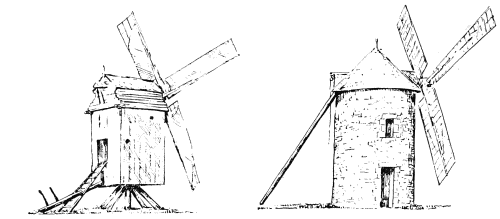
| Usual tail beam on post mills and hybrid mills. |
Tail beam. France, tower mill. |
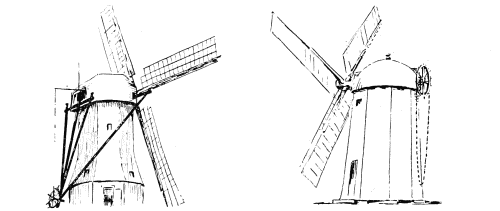
| Tiller on Holland mill. | Chain-wheel on tower mill. |
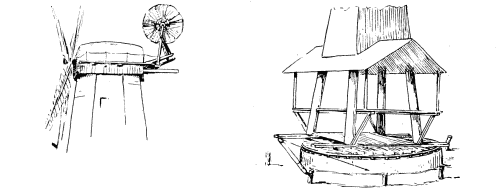
| Cubit’s automatic tail wheel, England. | Turntable mill, rollers and snubbing posts. |
| WINDMILL TAIL BEAMS OR TURNING GEAR. For keeping mill-head on the wind. |
|
Probably the next device for turning to the wind was the use of a chain pull, connected to overhead gear wheels and a cogged{183} track; for not only is this found in some early mills of Holland, and in the mills at Newport, R. I., but also in the rare old Peyto mill at Leamington, England, of 1632, of which I shall speak further. These chain pulls were either inside or out; the former being more protected from the weather.
But all these hand devices were completely eclipsed by another invention of Cubit—he of the “patent” sweep-shutter—known as Cubit’s tail vane. This was the use of a small wheel of from 4 to 10 vanes, usually 6, placed in the rear of the head of the mill, up aloft, and so connected by a train of small gearing that when it rotated it would turn the main head a little, and if need be follow up the variations of the wind. So accurately was this designed that it is said that even with the wind shifting but a couple of degrees around the horizon the tail wheel would then begin to turn, and with its gearing would in turn wind the mill head, carrying the sweeps, into the wind. This automatic arrangement was almost universally adopted in England, in the better class of mills; yet, with the stolidity of the Dutch temperament, apparently content to continue with hand labor as did their grandfathers,{184} this admirable device was rarely transplanted even to a place as nearby as Holland.
Turning now from the mechanical side of these old mills, as above, it is interesting to note the varied forms, uses and characteristics as found in the diverse parts of the world, and in the variety of races where and by whom these old home-made motors have been used.
Holland is usually taken as the home of the windmill, but that is so only in the greater proportionate number there in use than elsewhere. It is not true as regards origin nor the best development of them. It is a country notably flat, without water power, on the sea coast, and requiring great pumping equipment for draining, etc. This early resulted in the great number of windmills there found and associated with that little kingdom. It is said that in early days there were 10,000 of them. The greater number of them were used for lifting water to drain the “polders,” or meadows or lowlands, through the medium of a scoop wheel or Archimedes screw. Some of them can yet be seen and in use, with fat Dutch babies apparently ever on the edge of falling in the sluiceways, yet never doing so. Nearly all of{185} these mills have been replaced by great steam-driven government pumping stations. For sawing wood, also, great numbers are yet used in the Zaandam district, where several hundred can be seen almost adjacent, a vista and forest of windmills. And in the heart of the chief cities one yet sees, here and there, an old-time brick tower mill, probably 200 years old—a family heritage, with its clean and trim curtained little Dutch windows, its individual name, as of a ship, such as “The Admiral” or “The Parrot,” over the door, and its old coat of arms and carvings and touches of color. For the Dutchman is fond of his substantial woodwork, and of his bits of color; and such finds expression in his mills, where carving like the stern of an old galley and color stripings of all the rainbow are both tucked in and flagrantly added.
The characteristic of the Dutch mill is, however, that of a thatch covering, both on sides and top, on the usual size common mill—something not found in any other country. It is said of them that there is also a code worked out—sort of a wigwag or semaphore system—so that by the position of the vanes as left when shutting down, the long-distance observer can read whether a carpenter is needed or a baby has been born, etc., etc. Certain it is that the mills make fine elevations for flag-flying on holiday occasions, for then the staunch colors of Holland will be found on the flagpoles atop the most of them. In noting the Dutch mills, one cannot overlook—nor wants to—the picturesque little “petmolens” or “jaskers”—diminutive post pumping mills, for small fields only—that, with long, slender vanes, seen through the haze or afar, almost suggest one of the old rocs from Sinbad the Sailor, caught in the act of alighting.
England, while numerically far inferior to Holland, is yet far in advance from the viewpoint of the fullest engineering development of this world’s motor, as may be gathered from what has been said above as to the automatic shutters, tail vanes, etc. The largest, the most varied and the most efficient are found there. Many fine examples of these mills can be seen, a few of which are still in operation. In the south of England there are plenty of old wood structures of all forms—of which the turret is perhaps the most locally characteristic. This is a huge, or at least large size, post mill, often for some fine estate, with the base enclosed with a circular low or one-story building, used for storage, so that the external effect suggests a turret. In central England a good number of the tall brick tower mills yet stand.
For picturesqueness, however, no country surpasses old France. There the mills are small; the huge, towering structure{188} of the Dutch and English is unknown. But one can find many of great antiquity, great variety of form and of great charm. The type seems to be the true cylindrical tower—not tapering—with the cone top. In the racetrack at Longchamps, near Paris, is an instance, while on the golf course at St. Lunaire, overlooking the sea coast, on the Channel, as in innumerable other places in the northern part of France, these little sentries of the past can be found. Picturesque as they are, however, they are not yet as much so as even an older and cruder form suggesting an old blockhouse. For above the stone first story is an overhanging wood second story, as so well instanced at St. Briac. And in the Loire valley are the very unique hybrid mills with the folding boards vane arrangement, already referred to, which at Saumur date back to 1682, as doubtless do the others of that not-to-be-found-elsewhere form.
Of old post mills of the usual wood form France has plenty, of which the one on top of Montmartre, in the Moulin de la Galette grounds, is perhaps the most prominent. It is one of the two or three remaining that were part of a dozen or more that crowned that hill in the early days, as shown in several views of old Paris. What changes it has seen in its 600 years of accredited age! In its timbers are shot and balls of the revolutions of 1814 and 1871. Within are the old bells and bunks and shrines of the generations of millers who operated it, one of whom is said to have been killed and quartered and hung on the four arms of his own mill by the successful assailants. In the same premises is a dear little miniature mill, which, with diminutive stones of but 18 or 20 inches in diameter, was used for grinding spices, in place of the usual grain for bread.
In Belgium we find, in the main, the post and tower mills of{190} Holland and the Netherlands; while in Germany, as well, the similarity to the Dutch mills is the only or chief characteristic. In Denmark and Sweden and in Iceland are the usual mills of this section, excepting that their octagonal, typical squatty grist mill nearly always has the Turk’s head top instead of the irregular shape of Holland and Germany. And so pronounced is that that in Lawrence, Kan., where a mill was erected in 1858, with a Swedish top, inquiry develops that it was by Swedish emigrants. Iceland can claim probably the most northern mill ever erected, for in Reykiavik, a little isolated town of about 3000 inhabitants, we find an old mill, probably the first and only motor in the early days in Iceland.
There is greater picturesqueness—but, as usual, accompanied with less efficiency—in the southern part of Europe, as, for instance, in Spain. Here, aside from the jib flying mills of the{191}
Mediterranean, we find primitive construction, crude devices and even the clay water bottles, or jars, bound to a cumbrous wheel, slowly turning over by wind power, for lifting water for irrigation, similar to devices seen on the banks of the Nile—although there operated by oxen. And in Spain we tread the country where the ever immortal Don Quixote, despite the adjurations of the faithful Sancho Panzo, charged at full speed a flock of windmills on the plains of Montiel.
The crude structures of Greece and Turkey, already mentioned, are so crude that often no device is provided for turning to the wind, but, on the contrary, four mills are sometimes built in a field, facing, respectively, north, south, east and west; so that whichever way the wind comes some power can be secured. It is, however, more likely that prevailing winds are so constant{193} from one quarter there is but little use for a turning device, resulting in its omission.
And so one can go the world over and find these old mills; to the Barbadoes, where they are still extensively used—and of English type—for crushing sugar cane; to Jamaica, where they once were, as shown by an old print of the earthquake of 1792, in which several mills are depicted bodily upside down almost, as would be a child’s toy; to Peru, where over 13,000 feet above sea level in the Potosi silver mining districts of past times—centuries past—old prints show mills of the manifest Spanish type operating stamps for crushing silver ore; to the St. Lawrence, where the early settlers, both French and English, left their imprint in the shape of old mills on several promontories and points; to southern Illinois, where the German emigrants of the{194}
1820’s and ’30’s brought with them the mills of the Fatherland, etc. In all quarters of the globe the world’s chief motor for eight centuries can still be found.
And in closing this review of old windmills there is no instance to which reference should be made of quite as much interest as the old mill at Newport, known to every American antiquary and which, some two or three generations ago, was ingeniously ascribed to the Norse in the period of 1100 or thereabouts. This theory, while highly picturesque, was unfortunate chiefly in never having anything except surmise to back it up. Not a jot nor tittle of record or physical remains could be developed to substantiate it, and it has long since been practically dropped by most students of American history. And when the following, that has in recent years been developed, is borne in{196} mind, there seems no vestige of reason left in the Norse theory. There is no question as to the following facts in relation to the Newport mill, and I speak with confidence, having in person surveyed and thoroughly investigated both it and its English prototype, as described:
In 1675 Governor Benedict Arnold (the grandfather of the traitor) was in charge of the then early colony of Rhode Island. Sixty years before he had been born in the Warwickshire section, England, in which the Peyto estate was perhaps the greatest and finest. On that estate there was completed the most elaborate windmill ever built. Inigo Jones, England’s great architect of that time, designed it, and it was unique in its open arch design, its finely chiselled stonework and unusual adornment. Young Arnold was a lad of 17 at that time, and the building of this beautiful and remarkable windmill, in 1632, was, with small{197}
doubt, a marked episode in his life and knowledge. Forty odd years later, he, by the chance of fate, was the Governor of the Rhode Island Colony. With the destruction of a previous wood windmill of 1665, blown down in a great storm, it became his duty to provide another one for the use of the little colony. And there is small doubt, indeed, that in doing that he undertook to provide a mill that should be as nearly as possible a copy of the old mill at Chesterton, near Leamington—the best mill of which he knew. And so, without the measurements as to the general arrangement, size and design, from memory only, he there built, with the most limited facilities, a virtual replica of the Leamington-Peyto-Jones mill. In order to secure greater{198} permanence and protection against Indian attacks the mill was built of stone instead of wood.
For, while of course the fine stone work and carving and detail are missing, in this colonial condition, the general dimensions, the design and the interior arrangements are in substance the same throughout. It needs only the comparison of the plans of the two—side by side—to be satisfied as to that. Governor Arnold’s birthplace and connection afford the reason of the similarity, and his will even speaks of “my stone built windmill.” This old structure, still standing—as to its walls—in Truro Park, Newport, R. I., is perhaps America’s greatest colonial relic, and with its prototype of Chesterton constitutes the most unique pair of windmills, having the greatest historic interest, of any attaching to our country’s windmill history.
NOTE:
[A] Presented at a meeting of the Mechanical and Engineering Section, held Thursday, March 14, 1918.



